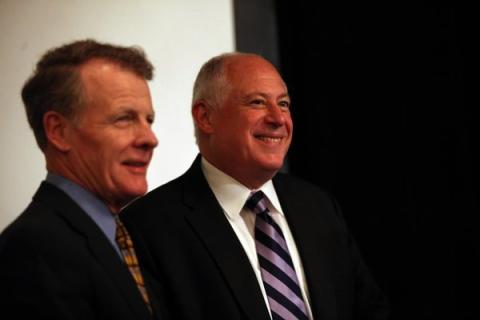report found that 14 Illinois counties had more registered voters than residents. It has also witnessed Illinois become a solidly Democratic state.
The causes are multiple. The recent Democratic ascendance has coincided with a period of unsatisfactory Republican governance and damage to the national party brand. It has also come with Illinois Democrats prevailing, however marginally, in Republican years. Altogether, it also helps explain what has made Illinois Democratic.
In 2010, Democrat Pat Quinn prevailed over Republican Bill Brady 46.7 to 45.9. However, out of 102 counties, Quinn won only three. One was Cook County, the site of Chicago and Quinn's home base. While 2010 was a good Republican year nationally, by failing to win the governorship, that year's census and the subsequent redistricting made Illinois more Democratic.
The results of the 2010 congressional elections gave Illinois eight Democrats and 11 Republicans in its delegation.
After redistricting, and the elimination of one district, Illinois' delegation after the 2012 elections shifted to 12 Democrats and only six Republicans. After redistricting, only eight districts were significantly close, with the winner receiving less than 60 percent.Of the ten districts where candidates received over 60 percent, seven were Democrats and all in the Chicago area. Of the three Republicans to win more than 60 percent, two were in southern and central Illinois, where Democrats exercise comparatively less power.
To top it off, some districts are drawn protecting practically any incumbent.
U.S. Representative Jesse Jackson, Jr., a Democrat under investigation for using campaign contributions for personal use, won his 2nd district seat in 2012 before abruptly resigning.
However, the investigation did little to depress his turnout or energize his political opponents. His percentage of the vote dropped from 81 percent in 2010 to 63 percent in 2012. Yet, his raw vote total increased from 150,666 to more than 181,000 in 2012.
In 2012, Jackson did face a primary opponent, the first "serious" intra-party challenger since he entered office in 1995. Even then, Jackson still won the primary with over 70 percent of the vote via 55,000 voters in an urban Chicago district.
Another, the 4th district, represented by Democrat Luis Gutierrez, was featured in the Economist as one of the more strangely-configured districts in the country. In 2012, Gutierrez was re-elected with 83 percent of the vote.
Voter turnout is also another issue in Illinois. According to the Chicago Tribune, there were almost 7.3 million registered voters prior to the 2012 primary. It marked a decrease of 318,000 since 2010.
Yet, even in Chicago, a city whose population is nearly three million, only 1.29 million are registered to vote. In the 2008 presidential primary, where both Democratic candidates had ties to the city, turnout only reached 52 percent. By the time of the 2012 primary, it fell to 24 percent, the lowest in seven decades. Throughout the rest of the state, turnout was 15 percent in 2012. The under-30 turnout was 4 percent.
district was new. Kinzinger won with a raw vote total of 9,000 in a district with Rockford, a metropolitan area with over 300,000 residents.In the primary between incumbent Republicans Adam Kinzinger and Don Manzullo, the effects of redistricting and turnout were on display. While the 16th district was officially Manzullo's, over 70 percent of the re-drawn
Accompanying voter turnout in Illinois is its semi-closed primary. Here, voters may ask for either a Republican or Democratic ballot, but they must declare party affiliation. Unaffiliated voters can ask for either ballot. So while independents are not shut out as in closed primaries, their choices are still hindered.
To resolve some of Illinois' electoral woes, Governor Quinn has suggested an open primary for Illinois. As the system operates today, primary election participation is public information. Charlie Wheeler, at the University of Illinois-Springfield, says both parties are unlikely to support an open primary because the current system essentially provides them with potential donor lists.
Yet, there is wide support for change in Illinois. A new poll from the Paul Simon Public Policy Institute found that even in southern Illinois, the only region of the state that can safely be said to be dominated by Republicans, three-quarters of voters desire an open primary.
Political dysfunction in Illinois marches on. There is some debate about what should be done, but there are a number of unmistakable factors that hamper the Land of Lincoln.
Photo Credit: Chicago Tribune
